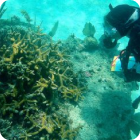Fish and Wildlife Research Institute (FWRI) Researcher Lindsay Huebner has combined her love of the ocean with her passion for solving environmental science puzzles throughout her education and career. Her graduate thesis project focused on corkscrew sea anemones and a cleaner shrimp which associates with them. These anemones and shrimp form “cleaning stations,” where the shrimp remove parasites and clean wounds on fish. Without this cleaning duo, fish health can suffer, causing ripple effects in reef ecosystems.
After time working at the Florida Aquarium, Lindsay joined FWRI to continue exploring complex environmental problems. The Foundation funded one of these projects: surveying benthic invertebrates and fish at ledges sites offshore from Tampa Bay. During the survey, Lindsay and her fellow researchers found cleaning stations like those she studied in grad school. Since the Tampa Bay region is not part of the anemone’s reported range, this was an unexpected discovery. It is not clear whether these anemones had been present but not documented in the Tampa Bay region previously, or if they have expanded their range due to warming oceans. She and her research collaborator from FWRI, Dr. Bob Ellis, are hoping to do an additional study to determine whether these habitats may be experiencing an influx of marine life normally associated with more tropical habitats further south.
Lindsay has also been an instrumental member of the Coral Reef Evaluation and Monitoring Project (CREMP). CREMP is one of the longest-term coral reef monitoring projects in the world. Researchers visit the Florida Keys and Dry Tortugas annually to assess coral health and population demographics. Lindsay and her colleagues have found that stony coral tissue-loss disease (SCTLD) has drastically affected the area. In fact, some coral species have completely disappeared from evaluation sites. To determine the cause of the disease, Lindsay and her collaborators from Mote Marine Laboratory, Drs. Erinn Muller and Abigail Clark, and The University of Miami, Dr. Stephanie Rosales, are taking tissue samples from diseased and apparently healthy corals. The microbiomes of the samples are then compared to evaluate what microbes are present, and whether there is a shift in the microbiome of coral disease lesions compared to the healthy corals. Water and sediment samples are also being collected to understand if there are microbial shifts in the environment due to the arrival of SCTLD. This project has found strains of bacteria in most of the coral lesions that are also present in the sand. Identification of these bacteria does not confirm that the disease is caused by them, as they might be a result of a secondary infection after a coral is already diseased. However, these results are important steps on the path to identifying the cause of SCTLD and its persistence in the environment. While working with diseased coral can be disheartening, Lindsay attacks it as a scientific question to solve.
Researchers like Lindsay are doing groundbreaking work trying to save Florida’s coral reefs. To support their efforts, donate here.












